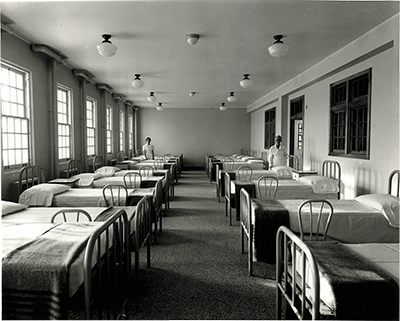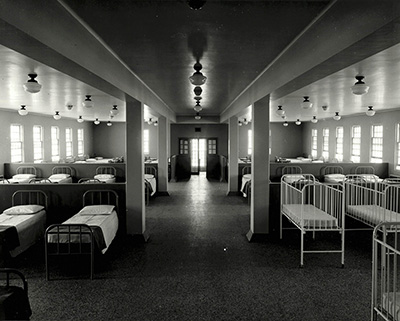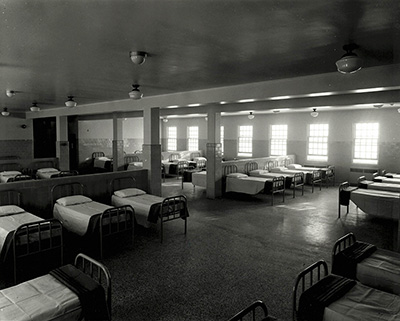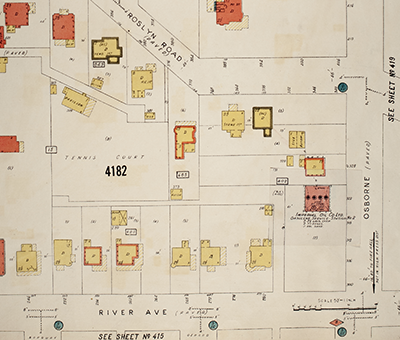Visit this blog for regular posts about Your Archives: The Histories We Share. Visit the Archives of Manitoba to see the records in person.
July 2021:
- July 23, 2021: Photographs of the Manitoba Developmental Centre – Submitted by Mary Horodyski, researcher and archivist
- July 9, 2021: Winnipeg fire insurance atlases – Submitted by Jim Blanchard, Historian
July 23, 2021
Photographs of the Manitoba Developmental Centre – Submitted by Mary Horodyski, researcher and archivist
“These photos show wards for residents at the Manitoba Developmental Centre (MDC). This is a provincially-run institution for people with intellectual and other disabilities that dates back to 1890. The photos are not dated, but could possibly be from the 1950s or early 1960s when the institution was named the Manitoba School for Mental Defectives.
“I choose these photos both for what they show and what they do not show. At first glance, we see rooms that are clean and tidy, with not a sheet or blanket out of place. In one of the rooms, we see that the cleanliness is overseen by two starched and forbidding uniformed women. But if we consider the photos a bit longer, many questions and some uncomfortable answers arise.

enlarge image
full size
“We may first notice that apart from the staff, the wards are empty of their residents. The history of people with intellectual disabilities has often been described as a history of people who were “hidden away” and these photos provide yet another degree to their segregation: they are removed even from photographs of what for many was their ‘home’ for many years. Then, we can count the beds and estimate the distance between each bed and imagine daily and nightly life in these conditions. In many of the wards, 30 to over 100 people lived together for years and even decades. Notice also the utter lack of personalization, each bed the same without any individual belongings. And who are the cribs for when young children were housed at other institutions, like St. Amant? We learn from other accounts that the cribs were for adolescents and grown adults with physical disabilities. Finally, look closely at the doorway at the back of the room – it has bars as the residents were locked in at night. Tragically, it was barred doors like these that contributed to the deaths of several residents when a fire broke out in a ward in 1977 and some of the residents were unable to escape.

enlarge image
full size

enlarge image
full size
“Archival evidence of the lives of people with disabilities is not easily come by, and when it exists, the records are often shielded by privacy laws. It behooves us, when evidence is available, to closely examine it, to read the records ‘against the grain’ as historians say, and to look, as much as possible, through a disability lens.1”
References:
- ^ For more information about the Manitoba Developmental Centre, see Mary Horodyski’s Masters of Arts thesis: https://mspace.lib.umanitoba.ca/handle/1993/32118 and her article “’A Very Serious Matter’: The Manitoba Government’s Institution for People with Intellectual Disability” in Prairie History, Number 1, Winter 2020.
Want to know more? Contact us for more information.
Want to participate in Your Archives? See Submit Your Story for details. You may e-mail us at [email protected] with a comment about this blog post and your comments may be included on this page.
July 9, 2021
Winnipeg fire insurance atlases – Submitted by Jim Blanchard, Historian
“In all my work on my histories of Winnipeg I have made extensive use of the fire insurance atlases. One that was especially useful was the atlas that includes maps of Roslyn Road and River Avenue.

enlarge image
full size
“My Winnipeg 1912 book contains a good deal of information about the community leaders who lived in this neighborhood. Using the atlas maps I can reconstruct such information as exactly where they lived, who their neighbours were, whether their homes were brick or wood and what property they owned and the outbuildings on it. This information is all very important in establishing a description of this group of Winnipeggers, many of whom were influential in the city.”
Want to know more? Search Keystone for more information.
Want to participate in Your Archives? See Submit Your Story for details. You may e-mail us at [email protected] with a comment about this blog post and your comments may be included on this page.



